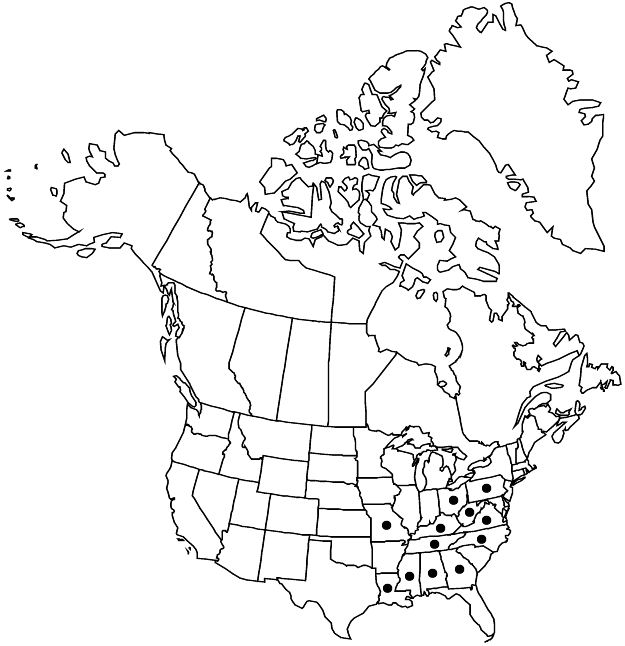Crataegus gattingeri
J. Elisha Mitchell Sci. Soc. 17: 12. 1900.
Shrubs or trees, 80 dm. Stems: twigs: new growth reddish, 1-year old deep reddish brown, 2-years old dark gray-brown, older deep gray; thorns on twigs straight to recurved, 2-years old very dark reddish brown or blackish, ± slender, 2.5–3.5 cm. Leaves: petiole length 50% blade, eglandular or with a few small glands; blade ± deltate to narrowly ovate, 2.5–5 cm, thin, base rounded to broadly cuneate, lobes 3 or 4 per side, sinuses shallow, lobe apex acute, margins serrate, teeth numerous, 2 mm, veins 5 per side, apex acute, surfaces glabrous, adaxial sparsely hairy young, especially midvein. Inflorescences 4–8-flowered; branches glabrous; bracteoles numerous, small, margins sessile- or stipitate-glandular. Flowers 15 mm diam.; sepals triangular, 4 mm, margins entire, pubescence not recorded; stamens 20, anthers pink to crimson, 0.3–0.4 mm; styles 4. Pomes greenish or greenish with pale blush young, ruddy to dull dark red when ripe, 6–10 mm diam., ± pruinose; sepals conspicuous, spreading; pyrenes 4.
Phenology: Flowering Apr–May; fruiting Sep–Oct.
Habitat: Open woodlands, brush
Elevation: 50–150 m
Distribution

Ala., Ga., Ky., La., Miss., Mo., N.C., Ohio, Pa., Tenn., Va., W.Va.
Discussion
Crataegus gattingeri extends from Missouri to Pennsylvania south to Louisiana, Alabama, and Georgia; it should be sought in southern Illinois and Indiana.
Crataegus gattingeri is similar to the variably hairy C. pruinosa var. virella, which has normal-sized anthers. Considerable similarity occurs between C. compacta and C. gattingeri; both may have stipitate-glandular bracteoles, the leaves and flowers are about the same size, and the thorn and twig colors are similar. In the latter species a greater range of leaf shape occurs, from narrowly ovate to practically deltate, and bases rounded to broadly cuneate. The lobes and apices of the leaves of C. gattingeri are usually much sharper. Crataegus gattingeri is also superficially similar to small-leaved forms of ser. Tenuifoliae such as C. iracunda, which also usually has particularly small leaves at anthesis. It differs from the latter primarily in its 20 stamens, small anthers, much less hairy adaxial leaf surfaces at anthesis, and more glandular-bracteolate inflorescences. These two may be difficult to differentiate in fruit. The author has not come across C. gattingeri var. rigida E. J. Palmer, from Indiana and Kentucky, which apparently differs from the widespread type variety in its stouter and flexuous twigs, stouter thorns, and smaller flowers. It would not seem to be part of C. gattingeri. Crataegus arcana Beadle represents a somewhat similar form of possible conspecificity.
Selected References
None.